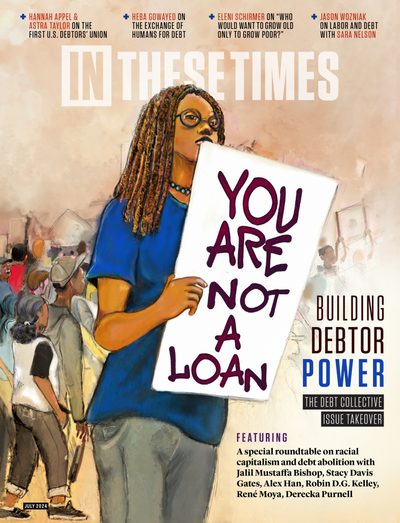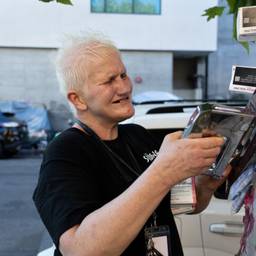The Future of Housing Organizing: Tenant Unions
The only answer to our housing crises is collective action. A growing movement of tenant unions promises a new front in the struggle for our homes.
Rose Lenehan and Tara Raghuveer

Daniel Tyson had 15 days to find a place he could afford.
For several years, Tyson lived at a hotel in St. Petersburg, Fla., where he paid $125 weekly. His rent would have been slightly less if he paid monthly, but the full-time warehouse shipping clerk couldn’t save enough. Then, developers decided to kick everyone out to demolish the building and expand a luxury hotel. It was October, and the snowbirds were beginning their trips south, a migration that makes the rental market even tighter. Daniel had nowhere to go.
Celia Williams had lived in her building in the Rogers Park neighborhood of Chicago for a little under a year when she began to see bed bugs. Several tenants reported the bugs to management; each received a text message claiming they were the only one who complained. For months, management refused to adequately address the problem; technicians would treat a single unit at a time. Burdened by tens of thousands of dollars in student debt, Celia didn’t want to spend the money to move — after all, conditions would probably be similar at the next building.
Felix Watson was paying $795 a month for a studio apartment in Raleigh, N.C. The building was in poor shape, but it was affordable on Felix’s salary as a Starbucks barista trainer. Felix was relieved to hear that the complex had been bought by a nonprofit affordable housing developer; the new owners even sent out Christmas cards. But then the rent went up to $845, and then to $1,100 a few months later, an increase of nearly 40%.
“I was in shock,” Felix said, noting they were also dealing with credit card debt and medical bills. “I was scared I was going to be homeless.”
In Louisville, Ky., Isaiah Threats moved into an apartment complex where he loved sitting on the porch and watching children play in the courtyard. It felt good to live in a community. But since he arrived about seven years ago, times have changed: Isaiah now pays more for less and says nothing works. He keeps his bathtub filled with water in case of a shutoff. Sometimes the heat doesn’t come on; other times, the air conditioning. Isaiah’s landlord, like many corporate owners, receives federal financing — a big loan with sweet terms and limited regulation. Meanwhile, the landlord hikes Isaiah’s rent every year, tacking on fines if he’s late and fees if he pays with a card.
“They’re squeezing us for every last dime and penny,” Isaiah said. “I don’t know where I’ll go if they raise the rent again.”
Rents are up more than 20% across the United States since 2020, and more than 22 million households are rent-burdened, paying more than 30% of their income in rent and utilities. Evictions are on the rise, with filings up 50% over pre-pandemic averages in many cities.
And as rents and evictions skyrocket, homelessness is at an all-time high, with more than 650,000 people sleeping outside. Meanwhile, 16 million homes sit vacant.
The crisis is obvious, but few can find common ground on solutions. The answer from developers, which serves their interests, is to build, build, build. They say the problem is underproduction. But even though multifamily housing has boomed in the past two years — with higher levels of production than the previous 50 years — the new units are mostly rented at market rate, not meeting the needs of working people.
For tenants, the market itself is the problem, prioritizing profits for landlords over safe and secure homes for the rest of us.
Tenants are up against one of the most potent forces in the world: consolidated real estate capital. The real estate lobby is among the highest-spending lobbies in the country, buying support from politicians of both major parties at every level of government. Groups like the National Association of Realtors (and their state and local counterparts) spend millions to fight rent control and other tenant protections. Elected officials reinforce their power through favorable policies, generous public subsidies, deregulation and deference. Trained by these lobbies, many politicians propagandize the expertise of the landlords and characterize their profiteering as charitable, referring to them as “housing providers.”

As landlords raise rents, as property managers shave off even the most basic maintenance costs, and as algorithms enable corporations to pre-screen and price gouge, tenants like Daniel, Celia, Felix and Isaiah are responding by joining tenant unions. Daniel joined the St. Petersburg Tenants Union; Celia, the Chicago Union of Tenants; Felix, the Triangle Tenant Union; and Isaiah, the Louisville Tenant Union.
Many tenant unions formed in response to the pandemic; some are in the early stages, canvassing for the first time, while others are several years into organizing, with clear structures and some victories. What’s emerging is an understanding that, for tenants to be able to contest for our homes and against our landlords and the powerful forces that enable them, we need to build big, militant organizations with deep roots in poor and working-class neighborhoods.
Tenants are transforming rent hikes, moldy bathrooms and eviction nightmares into power.
The tenant movement, in a phase of regrowth and reformulation, is nowhere near strong enough to win what we ultimately need: federal rent control, massive investments in public housing and an end to evictions and homelessness. But as tenants organize in more places, as unions in different cities and states build stronger relationships among themselves, and as more tenants become politicized by their circumstances, that horizon gets closer.
When Daniel, the warehouse clerk in Florida, faced eviction nearly three years ago, the tenant union was there. Unlike a social worker or a lawyer, the union framed the situation politically, about who had power and who didn’t, and what collective action could achieve. Daniel eventually had to leave the hotel where he lived — but he remained a member of the union, to continue fighting for himself and others.
We have each spent years organizing tenants: Rose with the Los Angeles Tenants Union (LATU), and Tara with KC Tenants in Kansas City, Mo. We’ve also connected tenant organizers across the country, learning from shared experience across different local contexts. Recent campaigns illuminate some of the potential of tenant unions, the challenges we encounter when we take on real estate capital, and the discernment needed to create good strategy and win.
In the early stages of a new movement, our unions have encountered critical questions about what to prioritize and where to focus: What kinds of fights will strengthen us? How can the fights we pick today help us grow to win bigger tomorrow?
In April 2024, Los Angeles Police Department officers escorted tenants who’d been on rent strike for nearly four years out of a city council meeting. “Hillside Villa no se vende! La lucha sigue sigue!” the tenants chanted (“Hillside Villa is not for sale! The fight continues!”).
Those tenants, members of the Hillside Villa Tenants Association, had just won a 10-year extension of their building’s affordability covenant. Rather than face eviction through a rent increase, they would keep their affordable rents and remain in their homes.
It was a significant victory, one that had seemed impossible when the tenants began organizing nearly six years prior. But they felt betrayed. Since 2020, they had been making a much more ambitious demand: for the city to seize their building from their landlord using eminent domain.
That, they argued, was the only way to keep the building permanently affordable.
Hillside Villa sits on a hill in Chinatown, a neighborhood that remains home to thousands of poor and working-class immigrants even as developers have sought to gentrify it. Since Hillside Villa was built in the late 1980s, the 124-unit complex had been protected by an affordability covenant: The developer had been given a 0% loan in exchange for keeping rents low for 30 years.
But in late 2018, the tenants were notified of jaw-dropping rent increases. A tenant who paid $845 for a three-bedroom apartment received a notice saying her rent would increase to $2,500. The 30 years were up.
Fifteen percent of the Los Angeles population lives below the federal poverty line. The city needs poor and working-class people, it would not function without their labor. For the Hillside Villa tenants, as for most tenants displaced from rent-stabilized homes in Los Angeles, losing their current apartments would mean becoming homeless or being forced to leave the city.
Between 2025 and 2030, affordability covenants will expire for more than 10,000 more units. Tens of thousands of tenants have already lost their rent-stabilized homes through “cash-for-keys” harassment (landlords paying tenants small amounts to vacate, so that they can double or triple rents) and evictions through the Ellis Act, a state loophole that permits landlords to evict tenants in order to “go out of business.” A recent UCLA study found that 40% of LA renters fear losing their homes and becoming homeless.
Fights against displacement have been at the heart of the LATU since our founding in 2015. An early LATU banner asked tenants, “Where will you go when you can’t afford your neighborhood?”
In smaller print below, it made a suggestion: “Why not fight to stay?” LATU has become the largest dues-funded tenant union in the country, with 3,000 households organized across 14 local chapters. From the beginning, we have organized bilingually, in Spanish and English; in the past few years, our organizing has become Spanish-dominant.
When Hillside Villa residents got their rent increases, the movement was ready. Two LATU organizers were fresh off a 2018 rent strike — which involved more than 100 families— and organizers from Chinatown Community for Equitable Development had won several anti-gentrification battles. With the support of interpreters, the tenants began holding weekly trilingual association meetings in English, Spanish and Cantonese. They began what may be the longest rent strike in LA’s history: Aided for several years by pandemic protections, more than 30 families haven’t paid rent since at least 2021.
Briefly, the possibility that the city would acquire Hillside Villa to make it permanently affordable seemed within sight. In May 2022, the LA City Council unanimously voted to pursue purchasing the building.
If the landlord was unwilling to sell, an incoming city council member, progressive Eunisses Hernandez, said she supported eminent domain.
But the victory announcement was premature. The landlord refused to allow city officials to conduct an appraisal, and the head of the Los Angeles Housing Department determined it would be too expensive to try to seize Hillside Villa from an unwilling seller, opening the city to lawsuit risk.
Eminent domain is for taking land from the poor, not the rich — the poor can’t afford to hire lawyers. And after pandemic eviction protections expired, the Hillside Villa tenants’ rent strike permitted their landlord to file eviction cases.
In April, abruptly, the City Council unanimously voted in favor of a very different deal. It would give the landlord $15 million to subsidize the lower, affordable rents for 10 more years, but not cancel the tenants’ rent debt. Most insultingly, tenants would have to pay 3% interest on their debt, whereas their landlord was still enjoying 0% and 1% loans. As this article goes to press, tenants are still pushing for a better deal.
The Hillside Villa Tenants Association turned the rent increases into the most public tenant battle in recent LA memory. Whereas previous rent strikes over large rent increases had focused on the landlords who were raising rents, Hillside Villa tenants made their impending homelessness the city’s problem. They camped outside the mayor’s house for a weekend, confronted the head of the LA Housing Department and disrupted City Council meetings.
Tenants sounded the alarm about the destruction of affordable housing in a way no policy report or editorial could.
The fight helped cement LATU’s politics. It allowed the union to collectively formulate and spread a critique of “affordable housing,” the dominant frame through which politicians grapple with the housing crisis. “‘AFFORDABLE HOUSING’ IS A SCAM!” the union wrote. “We challenge the tenant movement to reject the slippery language of ‘Affordable Housing’ and to openly demand social housing solutions outside of the market.”
Hundreds of tenants in other buildings have learned from and been inspired by Hillside Villa’s fight. Dozens of leaders can now speak from deep experience about how to build consensus, decide to take risks and sustain a group for years.
The most important legacy may be the public demand for eminent domain, the first loud echo in the United States of the Berlin campaign to expropriate corporate landlords in order to lower rents.
After the City Council vote in April, at a gathering in the Hillside Villa courtyard of a hundred union members, an elderly tenant sang in Cantonese: “Onward, toward victory!” In the tenants’ eyes, what they had won was 10 more years to fight. They continue to meet every Thursday evening.
A few weeks earlier and 1,500 miles away, tenants in Kansas City gathered at a pool hall, one of dozens of businesses on the site of a proposed downtown baseball stadium. The tenants had just defeated a 40-year sales tax, which would have generated $2 billion for the city’s two major sports franchises, the Royals and the Chiefs. The tax, plus a future deal with the city and the state, would have initiated the largest transfer of public wealth to private enterprises in the region’s history. Outspent 50-to-1, the opposition campaign, led by KC Tenants, won by 16 points.
At the victory party, Adrianna, a tenant in an income-restricted building on the proposed demolition line who asked to only use her first name, said: “These billionaires think they know what’s best for our city. They’re wrong, and today we proved that. We saved $2 billion for the people, and we saved our homes. It’s up to us to dream of better for our city.”
For a long time, Kansas City has been known as an affordable place to live and raise a family — even if that was never guaranteed for poor and working-class people. That’s all changing, fast. In recent years, Kansas City has become a destination for corporations, investors and major events, including part of the 2026 World Cup.
In 2023, Kansas City saw the worst rent hikes in the country, with 16.7% increases year-over-year. Street homelessness is on the rise.
As in many mid-sized Midwestern and Southern cities, politicians in Kansas City are desperate for the city to be something it’s not — a playground for tourists and yuppies— offering investors incentives like millions in decades-long tax breaks, for little more than gestures to community benefits.
As KC Tenants co-founder Diane Charity describes it: “Some leaders of Kansas City would sell us out for two chicken wings and a junket.”
Founded in 2019, KC Tenants organizes more than 10,000 members. Several hundred tenant leaders hold roles in the citywide union, one of the neighborhood unions or their building unions, and 31 tenant leaders govern the whole union on a strategy team; more than 550 tenant leaders hold roles in the citywide union. KC Tenants has secured free attorneys for every tenant in eviction court, won a $50 million bond for housing those at or below 30% area median income, banned voucher discrimination, captured and redistributed tens of millions from gentrifying developers, stopped thousands of evictions through direct action, won building-level improvements and rent protections and helped pass a Tenant Bill of Rights.
It was not a given that KC Tenants would take on the stadium sales tax. The union made the decision over three weeks, after nearly two years of internal discussions. KC Tenants meets every Saturday for two hours, and teams also meet separately to workshop proposals. Tenant leaders like Michael Savwoir and Denise Brown, longtime residents of Kansas City’s East Side, teamed up with leaders like Rhodes Conover, a tenant in Midtown, to develop a proposal for the stadium fight.
The union deliberated questions like: How do the potential risks stack up against potential opportunities? What would make this intervention “worth it” for the union? Why is this union business to begin with?
That question of “union business” became central. Some suggested the union should stick to material fights with more immediate outcomes. Others said the necessary fights can’t always be fought building by building. Tenants like DaJanae Moreland offered the provocation: “This fight is about who Kansas City is for. Is our city for the ultra-wealthy and the tourists, or the people who already call it home?”
Ultimately, 82% of the union voted to oppose the stadium sales tax and to campaign against it. KC Tenants made its stance public on February 19, which read in part:
“We love our city. Because of that love, we refuse to pay for our own displacement. As landlords raise rents across the city and as our people struggle to find decent homes, the proposed downtown stadium would usher in a new wave of gentrification, like such projects have in many other cities.”
This announcement kicked off a six-week campaign that involved knocking on thousands of doors, sending direct mail, running television ads, participating in public forums and telling tenant stories in the media.
Our opposition spent nearly $6 million—the most ever spent on a local election in our region’s history — and included three former mayors, the current mayor, our congressman, organized labor and every political establishment organization. Patrick Mahomes and Travis Kelce, the Chiefs’ star quarterback and tight end, respectively, spoke in ads encouraging a yes vote. Team owners manipulated Kansas City’s love with a threat: If you vote no, the teams will leave.
We won, but the stadium campaign was about more than that; we considered it an existential fight for our city. We were interested in building the union and shaping our political conditions. Our biggest fight yet, it required us to expand our base, develop existing leaders into new roles and test new infrastructure. KC Tenants recruited 114 new tenant leaders, who are now active union members.
Cathryn, a tenant who joined the union this year and asked to only use her first name, was responsible for getting a 32-foot banner into the Royals stadium on Opening Day, to be dropped over the fence near home plate during the third inning. Cathryn was nervous, but she folded the banner and got it into the stadium in her electric wheelchair. The action was a success.

Sarah Deeder, a tenant whose home would be destroyed by the proposed baseball stadium, spoke at rallies and recruited her neighbors. Longtime leaders took on new responsibilities, like running the press team and interpreting for bilingual community forums on tax policy.
And all the while, we continued our building-level and neighborhood-level organizing, despite some strain on the union’s capacity. Many of those tenant leaders, too, gained skills by participating in the union-wide campaign against the sales tax.
Today’s conditions put tenants in a precarious and soul-crushing daily existence; we break our backs and skip meals to pay the rent, with no end in sight. These conditions, manufactured by our landlords, intensify the power imbalance between us and them, trapping us in survival mode with little time to fight.
These conditions could move us to submission. Instead, they should move us toward strategic discernment. Tenant unions can’t and shouldn’t pick every fight that presents itself. We should build structures and processes that allow us to make collective decisions about which fights are worth our time.
What we’re looking for are fights that build the unions’ power, that bring more people in, that develop leadership, that demand city-wide attention, that create leverage over politicians, that allow us — rather than landlords and developers — to create common sense about the causes of and solutions to our problems.
No fight necessarily builds enduring power for a tenant union. Fights rooted in buildings can respond to urgent crises and develop leadership among neighbors, who take risks and try to win more than they could alone. But struggling one building at a time can tend toward the reactive and small-scale, and sometimes building-level unions disintegrate after immediate problems are solved.
To build city-wide unions, we need to be rigorous about developing leaders. We need to make sure building leaders are integrated into and supported by the larger, city-wide union, and that tenants are politicized around issues broader than their buildings, so that they develop identities as tenant unionists.
If city-wide unions want to pick broader, structural fights, they need to first understand their power relative to their context, running an honest assessment of the landscape to shape their campaign strategies. Tenant unions should think about and plan for escalation, and the unions should be clear that the campaign isn’t won until tenants feel the material outcome.
More than anything, we must develop collective muscle for strategic decision-making. Before a fight is chosen, we have to ask: What would this victory mean for tenants in our city? How do we build our power through this fight? How will it open up new possibilities?
And we have to commit ourselves to rigorous evaluation afterward, asking: What did we learn? How did this shift our position? What new organizational ability did we create? Who did the fight bring in, and how can we keep them?
Rent hikes, landlord harassment, displacement, the rich getting richer and us getting priced out — all of this can feel inevitable. But none of it is — not if we organize.
On the night of the stadium fight victory, Deeder spoke at the pool hall, in front of hundreds. She didn’t know all of their names or what had led them to join, but she knew the tenants there had banded together to fight for her home.
“[These conditions are] only inevitable if you roll over,” Deeder declared. “We won’t roll over. We’re not going anywhere.”
Tara Raghuveer is the founding director of KC Tenants and the National Tenant Union Federation.













